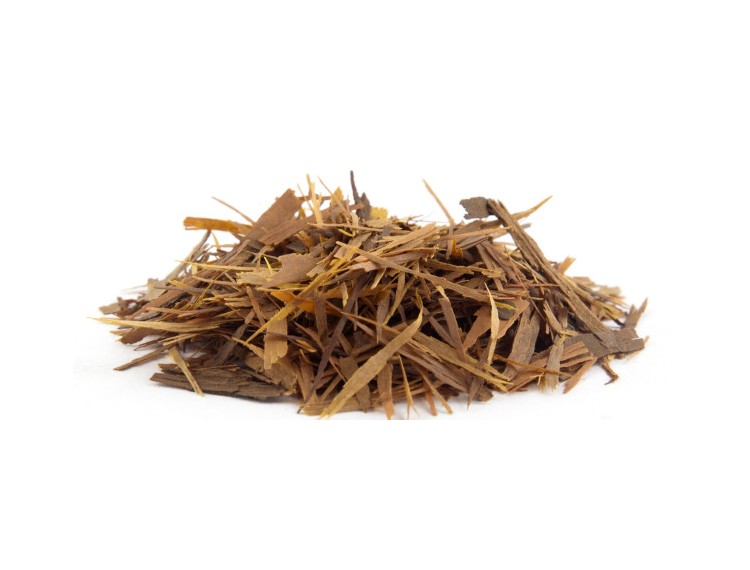Lapacho or Pau D'Arco
(€6.00 ανα 100 gr)
Lapacho or Pau D'Arco
Lapacho is an evergreen tree, with rosy coloured flowers. Lapacho is also known by the Portuguese name of Pau DΆArco, and by tribal names such as Taheebo and Ipe Roxo.
Health benefits of lapacho tea:
[nbsp][nbsp][nbsp] It treats and prevents different diseases, such as arthritis, diabetes, bowel problems, bladder infections, asthma and cancer. Its use in many ways parallels that of the immuno-stimulants echinacea on this continent and ginseng in Asia, except that its action appears to exceed them both in terms of its potential as a cancer treatment. The absence of side effects makes lapacho a treatment of choice even in conjunction with standard forms of therapy. The user has nothing to lose and much to gain from the judicious use of lapacho.
[nbsp][nbsp][nbsp] It has laxative effect. Regular use of lapacho will maintain regularity of bowel movements. Users of lapacho universally report a pleasant and moderate loosening of the bowels that leads to greater regularity without any unpleasant side-effects such as diarrhoea.
[nbsp][nbsp][nbsp] It works as a natural antibiotic.
[nbsp][nbsp][nbsp] It has anti-aging effect. Trials show definite inhibition of free radicals by lapacho constituents. Free radicals are even heavily implicated in the normal aging process. Reversing their action has become big business in world health circles.
[nbsp][nbsp][nbsp] It boosts the immune system and reduces the chances of contracting a medical condition due to its rather potent antimicrobial effects.
[nbsp][nbsp][nbsp] It increases blood and bone marrow health. Increased red blood cell production would improve the oxygen-carrying capacity of the blood. This, in turn, could have important implications for the health of tissues throughout the body.
[nbsp][nbsp][nbsp] It reduces the symptoms of the flu, colds, fevers, burns, respiratory distress, skin irritation, yeast infections, bone infections, dysentery and other infectious diseases.
[nbsp][nbsp][nbsp] Is also useful for treating chronic conditions such as lupus, psoriasis and ParkinsonΆs disease. The symptoms of HIV are also treated with lapacho tea.
[nbsp][nbsp][nbsp] It is useful in combating the side effects that commonly occur with different medications such as dizziness, nausea, anemia and diarrhoea.
[nbsp][nbsp][nbsp] It reduces pain, inflammation and other symptoms of arthritis due to its anti-inflammatory effects.
While there can be no doubt that lapacho is very toxic to many kinds of cancer cells, viruses, bacteria, fungi, parasites and other kinds of microorganisms, it appears to be without any kind of significant toxicity to healthy human cells. The side-effects mainly encountered, and usually with isolated lapacho constituents, are limited to nausea and anticoagulant effects in very high doses, a tendency to loosen the bowels, and diarrhoea in very high doses. However, some nausea should be expected as a natural consequence of the detoxification process.
How to prepare lapacho tea?
There are a number of unique ways to brew lapacho tea. Every region in each country has its own recipe for lapacho tea. The basic recipe for this tea that provides so many health benefits requires two teaspoons of lapacho tree bark for every litre of water. Infuse the tree bark into the boiling water and keep it on a low heat for five to ten minutes. Allow the tea to set for 20 to 30 minutes after removing it from the heat so that it will infuse fully. Keep the tea in your refrigerator after making it. Lapacho tea will stay fresh and retain its health benefits for a few days.
How much and when?
Lapacho can be used periodically as a preventative during colds and flu season, or whenever the chances for infections are high. Experience has taught that lapacho is best ingested as a tea, one or two cups a day, morning and evening. Used in this fashion, it promotes the health of the immune system, helps prevent the onset of colds and flu, keeps the bowel healthy and may impart some of the other important therapeutic effects, including a positive effect on arthritis, pain, localized infection (e.g. candida) and systemic infection.
During periods of acute, active infection, lapacho should be administered several times a day in tea form. It is up to the individual to determine the optimum amount for him or her.











































